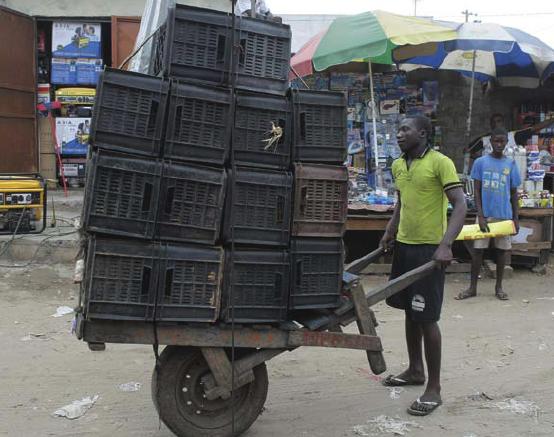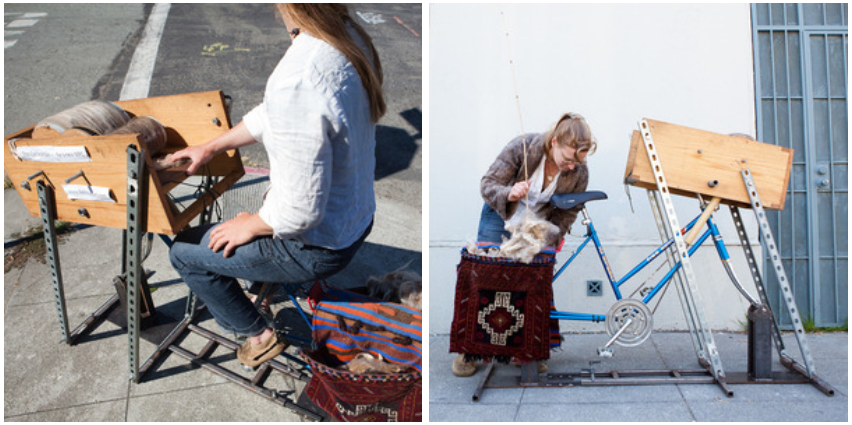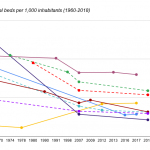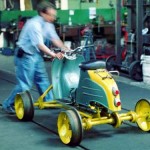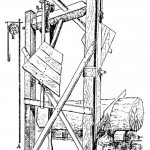Cut off by a relentless barrage of government shelling, activists in the besieged Syrian city of Homs have reverted to the age-old practice of using carrier pigeons to communicate with each other. More.
Mumbai Rickshaws
“Recognizing the role that auto-rickshaws play in sustainable urban transport and meeting daily commute needs in Mumbai will go a long way in improving conditions for drivers, as well as passengers, and will result in social and environmental benefits for Indian cities, as a whole.”
And why not in the rest of the world? Mumbai Rickshaws. Via Emile Hooge. More low-tech cars.
Pedal Powered Wool Carding Machine
The Cyclocarder by Fibershed-contributor Katharina Jolda is a wonderful update to the article on pedal powered machines. The Cyclocarder can turn your backyard, community center, or farm into a human powered wool processing station.
California Coolers
 “Coastal Northern California is blessed with a very moderate climate, generally on the cool side, especially at night. Before the refrigerator became common in households, denizens of this region took advantage of the cool weather by storing perishable foods in a special kitchen cabinet that brought in air from the outside – the California Cooler.
“Coastal Northern California is blessed with a very moderate climate, generally on the cool side, especially at night. Before the refrigerator became common in households, denizens of this region took advantage of the cool weather by storing perishable foods in a special kitchen cabinet that brought in air from the outside – the California Cooler.
The cooler cabinets were designed to hold fruits, vegetables, and other staples that needed to be kept cool but didn’t need to take up critical space in the era’s tiny ice boxes. The coolers were open to the basement to draw in cool air, which then wafted up and out a chimney or a wall vent.
When the refrigerator came along, it seems that, over time, the vents were boarded up and the California Cooler was all but forgotten. Today, if you walk the streets of my hometown, Berkeley, where most of the houses were built in the 1920’s, you will see many homes, and even apartment buildings, with the exterior vestiges of these vents.”
Read more: Resurrecting the California Cooler. Thank you, Adriana. Previously: Saving food from the fridge.
Energy Cannibalism
Energy cannibalism refers to an effect where rapid growth of an entire energy producing (or conserving) technology industry creates a need for energy that uses (or cannibalizes) the energy of existing power plants or devices. For the deployment of renewable energy and energy efficiency technologies to grow while remaining net greenhouse gas emission mitigators, they must grow at a rate slower than the inverse of their energy payback time.
- “Optimizing greenhouse gas mitigation strategies to suppress energy cannibalism“, J.M. Pearce, 2nd Climate Change Technology Conference, Hamilton, Ontario, Canada, May 12-15, 2009. (PDF).
- “Energy payback for energy systems ensembles during growth“, Timothy Gutowski, International Symposium on Sustainable Systems and Technologies, Washington D.C., May 16-19, 2010. (PDF)
- “Toward real energy economics: energy policy driven by life-cycle carbon emission“, R. Kenny, C. Law, J.M. Pearce, Energy Policy 38, pp. 1969-1978, 2010. (PDF)
- “Thermodynamic limitations to nuclear energy deployment as a greenhouse gas mitigation technology“, Joshua M. Pearce, Int. J. Nuclear Governance, Economy and Ecology, Vol. 2, No. 1., pp.113-130, 2008. (PDF)
Previously: Can renewables power consumer societies? The negative case.
